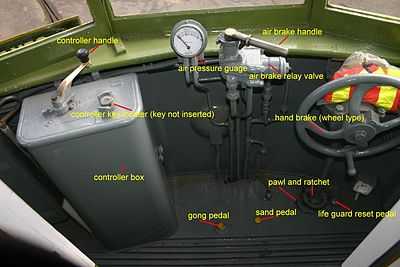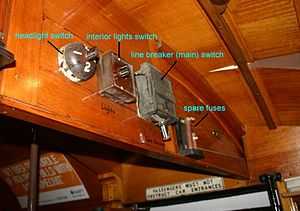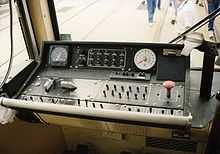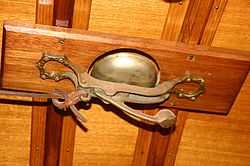Tram controls

The following article describes the controls on electric, rather than steam trams.
Overview
The operation of trams is relatively simple. As trams run on rails, they do not require steering controls. However they do require controls for the smooth application of power and for braking and to control forward and reverse running. Different controls were operated by the motorman's (driver's) hands or feet. In more modern vehicles controls are generally located on a driver console panel. Some controls can be used to do a variety of tasks. Trams do not have clutches or variable gears, although they do have fixed gears between their motors and wheels. Thus trams have no need for controls to operate their gears. Most of the important controls on a tram are actually electrical switches.
Power supply switches

Before a tram can be operated the main electrical circuit must be closed. This is done by the motorman moving a large overhead switch, usually located on the bulkhead behind the driving position, from the "off" to the "on" position.
Trams fitted with air brakes have a separate switch to operate the air compressor. This is sometimes located near the compressor (which is normally located under the floor of the passenger compartment) rather than in the driver's cabins.
Lighting and pole circuit switches
Usually located close to the overhead switch will be the light switches, which normally switch on both the interior lighting and the headlights. Double ended trams also have a switch to energise only the headlights at the end of the tram facing forwards. Trams with two trolley poles, may also have a pole circuit switch which ensures that only the pole on the overhead wire carries a current. Trams with pantographs will have a console switch or button to raise or lower the pantograph.
The "Key" - for forward and reverse operation
Forward and reverse operation is controlled by the key, which is usually the smaller of the two handles and located on the right-hand side of the top of the controller. Typically the key is pushed forward for forward operation, and backwards for reverse operation. There is usually a neutral or "off" position between forward and reverse positions. The key can only be removed from the controller at the neutral position.
The "Handle" - for power application
The "handle", which is normally the larger of the two levers on the controller is the device whereby the motorman controls the amount of power to be applied to the motors. It is normally located in the centre of the top of the controller. It can only be operated when the key (see above) is in the forward or reverse position. When the key is in the off position, or is removed, the handle is locked. Interlocking devices also normally ensure that the key can only be removed when the handle is in the off position.

In most traditional trams increased power is applied by turning the handle clockwise through a series of steps (or "notches") until full power is applied. Power is cut off by turning the handle anti-clockwise.
DC traction motors have the advantage of being able to deliver their full torque virtually immediately, but this comes with the risk of either the wheels slipping or rough, jerky starts, which is both uncomfortable to passengers and can damage the vehicle. The power must be gradually applied to the motors. On older trams, this was achieved by the use of a number of resistors, which are interposed between the controller and the motors and which are normally located under the car, or on its roof. The more resistors that are activated, the less power is available for traction purposes. As fewer resistors are activated, more power is available for the motors.
The activation of all or some of the resistors is achieved by opening and closing various electrical circuits between the controller, resistors and motors. By operating the handle on the controller, the motorman is actually opening and closing those circuits. On older vehicles the driver opens and closes circuits directly (sometimes called "direct control") and on newer vehicles the circuits are opened and closed by relays (sometimes called "remote control").
In both direct and remote control systems the handle is connected to a vertical shaft inside the controller and circuits are connected to the shaft by means of copper contactors or "fingers". Direct control controllers have larger contactors and fingers, owing to the larger electrical currents flowing through these components, while remote control controllers, relying on relays (and thus smaller currents), can utilise smaller contacts and fingers. The handle is rotated around the axis of this shaft to redirect the power to different circuits. Notches in the shaft allow the motorman to know when he or she has cleanly opened the correct circuit. A notch or "position" corresponds to a circuit. Different controllers have different numbers of circuits attached to different numbers of resistors and therefore different numbers of notches.

In addition, the motors can be operated in series circuits for slow speed or in parallel circuits for higher speeds.
While acceleration requires the gradual application of power to the motors, the opposite is the case when slowing the tram down. Moving the handle slowly back through the notches (called "back-notching") can result in damage to the controller circuits caused by electrical arcing. Instead the handle is quickly rotated anti-clockwise back to the off position and the brakes used to slow the tram.

Running a tram in anything but full series or full parallel wastes electricity and runs the risk of overheating the resistors and thereby causing a fire. The normal operating positions on the controller are therefore either full series or full parallel, with speed being controlled by judicious application of power, coasting (with no power applied) and braking.
From a standing start the motorman moves the handle from the off position, releases the brake, and then turns it through the series notches, thereby reducing the amount of power to the resistors and increasing the amount of power to the motors. When the "full series" notch is reached all power is routed to the motors running in series (effectively half speed). The motorman may safely continue to operate the tram in full series. If greater speed is required the motorman continues to turn the handle past a "transition point" between series and parallel notches and the motorman progresses gradually through the parallel notches. Power is again partially diverted to the resistors, until "full parallel" is reached, when all power is again routed to the motors, this time running in parallel.
PCC type controllers

PCC type controllers work using the same principle except that the circuits are opened and closed automatically (similar controllers exist on the Gothenburg M28, older Düwag built trams, some later British tram designs and Melbourne's Z1/Z2 class). This is controlled by a spring-loaded "governor" on the armature shaft of the motor. In this system, the accelerator (pedal) or controller (handle) controls the rate of acceleration, and since full series and full parallel are still the normal operating positions, speed is controlled by automatically cutting power above a speed which depends on the position of the accelerator/controller and then automatically coasting and braking as above.
Power supply in modern trams
On modern trams, power supply is controlled with thyristors (which can switch power supply on and off much faster than a motorman could), freewheel diodes which supply power when it is not supplied via the thyristor, and lowpass filters, known as line filters, which attempt to remove any remaining AC "ripple". Sometimes, when more than one traction motor is used, an individual chopper is provided for each traction motor, operating out of phase, to cancel out as much interference as possible.
In simple terms the thyristors supply power to the motors by the very rapid switching on and off of the power supply. As more power is required, the "on" period is increased and the "off" period is decreased. This is handled automatically by the thyristors and the driver makes no conscious decision to switch the power on and off.
Because of the rapid on/off switching, in any setting between neutral and full power, undesirable "AC ripple" in the current can cause the motor housings to vibrate, increase the risk of motor bearing failure through shaft induced voltage and waste energy through eddy currents and switching losses. Ripple can also cause electrical interference (this is why modern trams tend to generate electrical "hum" at low speed). Although lowpass filters attempt to overcome this problem, modern trams are best run in full series or full parallel, as is the case with trams with older technology.
Pointswitching
In some tramway systems points (switches) could be activated by the motorman from inside the tram, while the tram was still moving. In a commonly used and simple arrangement, the points would be operated by the motorman "cutting off" (i.e. returning the handle to the off position) or keeping power on while the tram passed beneath a special contactor in the overhead wires. The contactor would sense whether the tram was drawing electricity from the overhead. If the motorman cut off power the points were to be set for straight ahead. If the motorman kept the power on, the contactor sensed power was being drawn and the points would be set for the branch line. Because of their heavier demand on power, even when coasting, modern all-electric trams tend not to rely on this form of point switching.
In other more sophisticated systems the points are activated by a button on the driver's console, which sends a small electric ripple signal through the overhead to the points activator. Another system requires a transponder under the tram being recognised by a sensor which then sets the points for the appropriate track, depending on the route the tram is intending to take and which has been pre-programmed into the transponder.
Braking controls
Generally trams will have a number of braking systems, for use in three situations - general (or service) use, emergency use and immobilisation when the tram is not in use.
Originally electric trams only had hand operated braking systems, similar to horse trams from which they evolved. Hand brakes tended to be hard to use and slow to activate. As trams became larger and heavier, other braking systems, such as air brakes, or rheostatic brakes were adopted. Magnetic track brakes were sometimes adopted as an emergency braking system and always are on modern trams.
Hand brakes - brake wheels, "goosenecks" and pawls
All older types of trams were fitted with a hand brake which could be used to safely immobilise the tram when it was switched off, or when the power was disconnected from it for some other reason. Often this "park brake" took the form of a small, vertically mounted wheel, often with a handle. As the wheel was turned the braking mechanism forced brake shoes down onto the wheels.
When used as a service brake, the hand brake is typically connected to a gooseneck handle, which, like the controller's key and handle described above, rotates around a vertically mounted shaft and thus turns in the horizontal plane. It is normally operated with the right hand.
By turning the gooseneck handle clockwise the brake shoes are applied to the wheels. Brakes are released by operation of strong springs. To enable sufficient pressure to be applied to the brake shoes and also to overcome the resistance provided by the release springs, the base of the hand brake normally consists of a small gear under the floor of the tram, which is permanently meshed to a much larger gear which then connects to the rest of the braking mechanism. This means that the motorman must turn the brake handle many times to have any effect.
A major risk in operating the hand brake is the possibility of the handle slipping from the motorman's hand and the brake releasing uncontrollably. To minimise the possibility of this occurring, the motorman can knock a locking pawl into place using his right foot. With this in place the brake can be tightened but not released, until the motorman knocks the pawl out of the way.
Air-operated brakes
Older style trams frequently use a simplified form of Westinghouse railway brake. The brake is applied by allowing compressed air to enter a large brake cylinder (or cylinders), which pressed brake shoes onto the wheels. The brake system is operated by means of a valve, usually operated by the motorman's right hand. In most systems the brake is applied by turning the brake valve handle anti-clockwise, although in Sydney, Australia this operation was reversed.
Older brake valves were "manual lapping", where the driver had to constantly adjust the position of the valve handle to maintain pressure in the brake cylinder. Newer valves are "self-lapping" where the driver holds the valve handle in one place in order to hold the brake pressure constant. Moving the handle on self-lapping valves will increase or decrease the braking pressure.
Many trams with air brakes had an emergency brake handle in the passenger compartment which could be operated by the conductor or passengers. These operate by means of a simple valve which dumps all available pressure into the brake cylinder.
Track brakes
This form of braking applied the brakes to the track, rather than the wheels. Originally they were operated by means of a large lever which was pulled back towards the driver, similar to the track brakes on cable cars. They were comparatively rare on older electric trams. Modern trams use electromagnets to force heavy blocks down onto the track. These were activated by means of a button or switch, or in some more recent systems by simply releasing the "dead man's handles" while the vehicle is moving.
Rheostatic and regenerative brakes
Rheostatic brakes used the motors as generators, dissipating the energy so created in additional resistor banks located underneath or on the roof of the tram. Trams fitted with rheostatic brakes had special circuits in their controllers and special handles. The motorman would move the handle anticlockwise, past the "off" position to a series of braking positions. The tram would be brought to a complete halt by applying the hand brake.
Regenerative brakes are a more modern version which feed the electricity back into the power network.
Use of motors as emergency brakes
There are two ways in which the motors could be used to slow the tram in emergencies. First it is possible to use the motors effectively as generators and thereby slow the tram. This is normally done by simply moving the "handle" to the off position and then moving it back to a low series notch.
A more radical form of emergency braking is to move the "key" from forward to reverse. Depending on how the tram has been wired this may also require the motorman to first switch the tram's overhead switch off and then move the handle to a parallel notch.
In any emergency braking event drivers are trained to first apply sand to the track. This is discussed below.
Sanders
Sand is used by trams to stop wheels slipping, or to assist wheel grip in emergency braking situations. Usually sand was stored in bins under the seats in the passenger cabins close to the wheels. Generally in older vehicles the sander was operated by a small pedal in the floor. The pedal operated to open the sanders either mechanically or by air pressure. In more modern vehicles the sanders are operated electrically by pressing a button on the operator's console. Normally the sand is dropped in front of the wheels onto the track, but in some trams in Brisbane, Australia sand could also be dropped behind the wheels, in case the tram was slipping backwards on steep track. In these trams the driver depressed the sand pedal lightly to drop the sand in front of the wheels, but fully depressed the pedal to drop sand behind the tram wheels.
Warning and communication devices

The traditional warning device on trams is a large gong (not unlike the gongs used to start and stop boxing fights). Tram gongs were pulsed by depressing a foot pedal, with the gong located directly below the pedal, under the floor. In some later trams the gong was operated by air pressure, again activated by depressing a floor pedal or by pushing a console button. In some areas, particularly in Europe an electric bell was employed, controlled by floor pedal or console button, these bells would ring continuously with the button/pedal depressed and thus were not unlike alarm bells.
Many modern trams in both Melbourne and many European cities – especially low floored models – use an amplified, digital recording of a tram gong, rather than an actual gong under the tram, with the use of a supplementary horn common.
An additional means of communication are the conductor's bells. These are smaller bells, or buzzers, usually ceiling or wall mounted, located above or beside the motorman. They were either operated by the conductor pulling a leather or rope cord which ran the length of the tram, or in the case of electric buzzers, operated by the conductor pressing a button in the passenger cabin (or rarely on the outside of the tram). In some systems passengers were allowed to ring the conductor's bell to let the driver know that they wanted to be let off at the next stop. Drivers could also communicate to the conductor using the bells.
The number of times the conductor's bell was rung would indicate what was required to be done. The following is a typical code as operated in Brisbane Australia:
conductor to motorman -
- one ring - stop at next stop
- two rings - all clear, driver may proceed
- three rings - emergency stop
- four rings - tram is full, do not stop to pick up additional passengers
motorman to conductor -
- one ring - release the hand brake
- two rings - I have control of the hand brake
- three rings - emergency stop
- four rings - come here
Safety equipment
Generally older trams did not include "dead man's handles", although in some parts of the United States and United Kingdom their use became mandatory in the 1930s after a number of court cases involving trams that had run out of control and crashed. A similar court case was held in the 1930s in NSW involving a run-away tram and the court recommended that dead man's handles be fitted to NSW trams, but the government forgot to implement the recommendation. Being very difficult and expensive the case was forgotten after the war, although Sydney did experiment with deadmans' which cut the power without applying the emergency brake.
A primitive type of dead man's handle, in use among others in some prewar European trams, was a system where continuous pressure had to be applied to the handle to keep the motors under power. To reduce power to the motor, the handle had first to be let go all the way down to zero (the "coasting" position). This was not a full-fledged dead-man's-switch since there was no automatic braking. Later trams have a "real" dead-man's control, e.g. a pedal which applies emergency brakes if it is either fully depressed or fully released.
Where no deadman's handle was provided, the conductor would be responsible for stopping the tram in the event of the driver becoming incapacitated. This would usually be carried out from the rear platform, with the conductor opening the circuit breaker to cut power and then applying the brakes. On mechanically braked trams this would usually be done by winding on the mechanical brake, on air braked trams an emergency brake handle would usually be provided for this purpose.
Many trams have "lifeguards", which are devices in front of their bogies designed to prevent persons being caught between the wheels. Typically the lifeguard has a mechanism close to the front of the tram which, when triggered, causes a large grill or scoop to drop down onto the road in front of the tram's leading bogie. Once the emergency has passed, or if the lifeguard was accidentally tripped, it needs to be reset. In many older trams there is a third foot pedal which the motorman can depress to reset the mechanism.
Gauges
Pre-war trams rarely had speedometers fitted. Generally the only gauge in the driver's cabin indicated air pressure. Modern trams (which do not rely on compressed air to operate doors or brakes) do not need pressure gauges but always have speedometers.
Windscreen wipers
As with any vehicle with windscreens, trams require windscreen wipers to enable the driver to see through the windscreen in wet or snowy conditions. The earliest versions of wipers were spring-loaded and operated manually by the driver. Later versions were operated by bleeding a small amount of compressed air, via a small pipe, off the air brake system. Normally the control for the air operated windscreen wipers was a small valve located on the wiper mechanism, with the speed of the wiper controlled by the amount of compressed air allowed into the wiper mechanism. Modern trams that do not have air brake systems instead use small electric motors to operate the wipers. The control switch for electric wipers will generally be found on the driver's console.
The fronts of very early trams were open to the elements and did not have windscreens. However all modern trams have enclosed fronts.